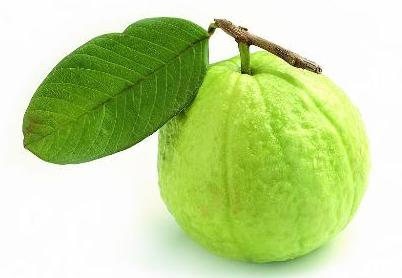
guava ['gwɑ:və]n. 番石榴,番石榴其果实
上图就是番石榴的样子,真是涨知识了。言归正传,下面我们来学习一下Google的Guava Cache
适用场景
- 重复计算或检索相对稳定的数据
- 愿意消耗一些内存空间来提升速度。
- 你预料到某些键会被查询一次以上。
- 缓存中存放的数据总量不会超出内存容量。
GuavaCache与ConcurrentMap的区别
- ConcurrentMap不会自动移除元素,也就是元素的有效性由使用者来维护,失效了需要式地移除。
- Guava Cache为了限制内存占用,通常都设定为自动回收元素。
CacheLoader介绍
LoadingCache是附带CacheLoader构建而成的缓存实现。从字面意思理解就是缓存加载器,继承虚类CacheLoader需要重载方法
public abstract V load(K key) throws Exception;该方法实现value的计算逻辑,当获取不到key对应的value值时
GuavaCache会计算一次值并把值缓存到内存中,再次获取如果缓存中存在对应的值就直接获取不在调用费时的计算逻辑,例如:
new CacheLoader<Integer, String>() {
@Override
public String load(Integer integer) throws Exception {
return productValue(integer);
}
final static String productValue(Integer integer) throws InterruptedException {
String value = "";
if (integer != null) {
value += String.valueOf(integer) + System.currentTimeMillis();
}
Thread.sleep(1000);
return value;
}
productValue是一个耗时操作,以一个整数为key,以key+System.currentTimeMillis()字符串为value,这里为了模拟费时操作
使用了Thread.sleep(1000);,第一次获取数据会比较慢,以后只要缓存有效获取效率能大幅提高。
注意:自己定义的CacheLoader如果可能抛出异常使用get,如果会抛出异常则使用getUnchecked
Callable介绍
所有类型的Guava Cache,不管有没有自动加载功能,都支持get(K, Callable)方法。这个方法返回缓存中相应的值,或者用给定的Callable 运算并把结果加入到缓存中。这个方法简便地实现了模式”如果有缓存则返回;否则运算、缓存、然后返回”。例如:
Cache<Integer, String> myCache = CacheBuilder.newBuilder()
.maximumSize(1000)
.build();
try {
for (int i = 0; i < 10; i++) {
final Integer a = i;
System.out.println(myCache.get(i % 5, new Callable<String>() {
@Override
public String call() throws Exception {
return productValue(a);
}
}));
}
} catch (Exception e) {
e.printStackTrace();
}
显式插入
使用cache.put(key, value)方法可以直接向缓存中插入值,这会直接覆盖掉给定键之前映射的值。使用Cache.asMap()视图提供的任何方法也能修改缓
存。但请注意,asMap视图的任何方法都不能保证缓存项被原子地加载到缓存中。进一步说,asMap视图的原子运算在Guava Cache的原子加载范畴之外,
所以相比于Cache.asMap().putIfAbsent(K,V),Cache.get(K, Callable<V>) 应该总是优先
缓存回收
GuavaCache提供了三种基本的缓存回收方式:基于容量回收、定时回收和基于引用回收。
基于容量的回收(size-based eviction)
- 只需使用
CacheBuilder.maximumSize(long)缓存将尝试回收最近没有使用或总体上很少使用的缓存项。——警告:在缓存项的数目达到限定值之前, 缓存就可能进行回收操作——通常来说,这种情况发生在缓存项的数目逼近限定值时。 - 另外,不同的缓存项有不同的“权重”(weights)可以使用
CacheBuilder.weigher(Weigher)指定一个权重函数,并且用CacheBuilder.maximumWeight(long)指定最大总重。除了要注意回收也是在权重逼近限定值时就进行了,还要知道权重是在缓存创建时计算的,因此要考虑重量计算的复杂度。注意:权重大小并不决定 缓存对应是否会被优先回收,当缓存中的权重值逼近或达到指定的最大值时,缓存将尝试回收最近没有使用或总体上很少使用的缓存项。
public class MyGuavaSimpleCache {
public static Cache<Integer, String> MY_CACHE = CacheBuilder.newBuilder()
.maximumSize(1000)
.maximumWeight(10000)
.weigher(new Weigher<Integer, String>() {
@Override
public int weigh(Integer key, String value) {
return key;
}
})
.build();
}
注意:当有多个缓存回收条件时,可能会先触发其中一个或单个
定时回收(Timed Eviction)
expireAfterAccess(long, TimeUnit)当缓存项在指定的时间段内没有被读或写就会被回收。expireAfterWrite(long, TimeUnit)当缓存项在指定的时间段内没有更新就会被回收。refreshAfterWrite(long, TimeUnit)当缓存项上一次更新操作之后的多久会被刷新。
expireAfterWrite和refreshAfterWrite异同
refreshAfterWrite的特点是,在refresh的过程中,严格限制只有1个重新加载操作,而其他查询先返回旧值,
这样有效地可以减少等待和锁争用,所以refreshAfterWrite会比expireAfterWrite性能好。但是它也有一个缺点,
因为到达指定时间后,它不能严格保证所有的查询都获取到新值。了解过guava cache的定时失效(或刷新)原来的同学都知道,
guava cache并没使用额外的线程去做定时清理和加载的功能,而是依赖于查询请求。在查询的时候去比对上次更新的时间,
如超过指定时间则进行加载或刷新。所以,如果使用refreshAfterWrite,在吞吐量很低的情况下,如很长一段时间内没有查询之后,
发生的查询有可能会得到一个旧值(这个旧值可能来自于很长时间之前),这将会引发问题。
基于引用的回收(Reference-based Eviction)
通过使用弱引用的键、或弱引用的值、或软引用的值,Guava Cache可以把缓存设置为允许垃圾回收
CacheBuilder.weakKeys()使用弱引用存储键。当键没有其它(强或软)引用时,缓存项可以被垃圾回收。因为垃圾回收仅依赖恒等式(==),使用弱引 用键的缓存用==而不是equals比较键。CacheBuilder.weakValues()使用弱引用存储值。当值没有其它(强或软)引用时,缓存项可以被垃圾回收。因为垃圾回收仅依赖恒等式(==),使用弱 引用值的缓存用==而不是equals比较值。CacheBuilder.softValues()使用软引用存储值。软引用只有在响应内存需要时,才按照全局最近最少使用的顺序回收。考虑到使用软引用的性能影响, 我们通常建议使用更有性能预测性的缓存大小限定(见上文,基于容量回收)。使用软引用值的缓存同样用==而不是equals比较值
显式清除
任何时候,你都可以显式地清除缓存项,而不是等到它被回收
- 个别清除:
Cache.invalidate(key) - 批量清除:
Cache.invalidateAll(keys) - 清除所有缓存项:
Cache.invalidateAll()
移除监听器
- 通过
CacheBuilder.removalListener(RemovalListener),你可以声明一个监听器,以便缓存项被移除时做一些额外操作。缓存项被移除时,RemovalListener会获取移除通知[RemovalNotification],其中包含移除原因[RemovalCause]、键和值。 - 请注意,
RemovalListener抛出的任何异常都会在记录到日志后被丢弃[swallowed]。
public class MyCacheListener implements RemovalListener<Integer, String> {
@Override
public void onRemoval(RemovalNotification<Integer, String> notification) {
System.out.println("key:" + notification.getKey());
System.out.println("value:" + notification.getValue());
}
}
警告:默认情况下,监听器方法是在移除缓存时同步调用的。因为缓存的维护和请求响应通常是同时进行的,代价高昂的监听器方法在同步模式下会拖慢正常的
缓存请求。在这种情况下,你可以使用RemovalListeners.asynchronous(RemovalListener, Executor)把监听器装饰为异步操作。
清理什么时候发生?
- 使用
CacheBuilder构建的缓存不会”自动”执行清理和回收工作,也不会在某个缓存项过期后马上清理,也没有诸如此类的清理机制。相反,它会在写操作时 顺带做少量的维护工作,或者偶尔在读操作时做——如果写操作实在太少的话。 - 这样做的原因在于:如果要自动地持续清理缓存,就必须有一个线程,这个线程会和用户操作竞争共享锁。此外,某些环境下线程创建可能受限制,这样
CacheBuilder就不可用了。 - 相反,我们把选择权交到你手里。如果你的缓存是高吞吐的,那就无需担心缓存的维护和清理等工作。如果你的 缓存只会偶尔有写操作,而你又不想清理工
作阻碍了读操作,那么可以创建自己的维护线程,以固定的时间间隔调用
Cache.cleanUp()。ScheduledExecutorService可以帮助你很好地实现这样的定时调度。
刷新
- 刷新和回收不太一样。正如
LoadingCache.refresh(K)所声明,刷新表示为键加载新值,这个过程可以是异步的。在刷新操作进行时,缓存仍然可以向其 他线程返回旧值,而不像回收操作,读缓存的线程必须等待新值加载完成。 - 如果刷新过程抛出异常,缓存将保留旧值,而异常会在记录到日志后被丢弃[swallowed]。
- 重载
CacheLoader.reload(K, V)可以扩展刷新时的行为,这个方法允许开发者在计算新值时使用旧的值。
//有些键不需要刷新,并且我们希望刷新是异步完成的
LoadingCache<Key, Graph> graphs = CacheBuilder.newBuilder()
.maximumSize(1000)
.refreshAfterWrite(1, TimeUnit.MINUTES)
.build(
new CacheLoader<Key, Graph>() {
public Graph load(Key key) { // no checked exception
return getGraphFromDatabase(key);
}
public ListenableFuture<Key, Graph> reload(final Key key, Graph prevGraph) {
if (neverNeedsRefresh(key)) {
return Futures.immediateFuture(prevGraph);
}else{
// asynchronous!
ListenableFutureTask<Key, Graph> task=ListenableFutureTask.create(new Callable<Key, Graph>() {
public Graph call() {
return getGraphFromDatabase(key);
}
});
executor.execute(task);
return task;
}
}
});
注意:CacheBuilder.refreshAfterWrite(long, TimeUnit)可以为缓存增加自动定时刷新功能。和expireAfterWrite相反,refreshAfterWrite通过定
时刷新可以让缓存项保持可用,但请注意:缓存项只有在被检索时才会真正刷新(如果CacheLoader.refresh实现为异步,那么检索不会被刷新拖慢)。
因此,如果你在缓存上同时声明expireAfterWrite和refreshAfterWrite,缓存并不会因为刷新盲目地定时重置,如果缓存项没有被检索,那刷新就不会
真的发生,缓存项在过期时间后也变得可以回收。
统计
CacheBuilder.recordStats()用来开启Guava Cache的统计功能。统计打开后,Cache.stats()方法会返回CacheStats对象以提供如下统计信息
- hitRate():缓存命中率;
- averageLoadPenalty():加载新值的平均时间,单位为纳秒;
- evictionCount():缓存项被回收的总数,不包括显式清除。 此外,还有其他很多统计信息。这些统计信息对于调整缓存设置是至关重要的,在性能要求高的应用中我们建议密切关注这些数据。
本文由 zealzhangz 创作,采用 知识共享署名4.0 国际许可协议进行许可
本站文章除注明转载/出处外,均为本站原创或翻译,转载前请务必署名
最后编辑时间为:
2018/01/17 22:12

